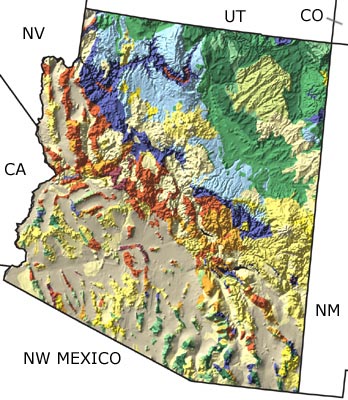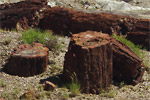Arizona, US
|
|
|||||||||||||||||||||||||||||||||||||||||||||||||||||||||||||
Paleontology and geology
The Precambrian: Precambrian rocks in Arizona record at least three sequences of deposition, metamorphism, and erosion. Fossils from the Late Precambrian are rare but include stromatolites, indicating that shallow marine conditions prevailed during this time.
The Paleozoic: Paleozoic rocks are well represented in Arizona. Cambrian sedimentary rocks, found in the western part of the state, contain fossils of trilobites, brachiopods, and other organisms that record the shallow marine conditions that prevailed during this time. Most of Arizona stood above sea level during the Ordovician and Silurian. There are a few exposures of Ordovician rocks remaining in the state, but erosion has removed any Silurian rocks and fossils that might have existed. Fossils of corals, brachiopods, and other marine organisms indicate the return of a shallow sea during the Devonian. During the Carboniferous, fluctuating sea levels led to the deposition of marine and coastal plain sediments during times of high water, and to deposition of salts when sea level dropped. In the Permian, tectonic activity to the southeast provided abundant sediment to rivers and streams, and eventually to the sea. In the Late Permian, fossils of marine organisms indicate that a shallow sea covered most of the state once again.
The Mesozoic: During the Mesozoic, much of Arizona was a vast, low-lying landscape, although tectonic activity raised the southwestern part of the state. Remains of forests that grew in the state during the Triassic can now be seen as fossilized logs in Petrified Forest National Park. Dinosaurs roamed the riverbanks and wind-sculpted dunes of the state during the Jurassic, leaving behind their footprints. Mountain building continued into the Cretaceous in the western part of the state, while shallow seas flooded into northeastern and southeastern Arizona. Turtles, plesiosaurs, and other marine reptiles thrived in the warm waters.
The Cenozoic: Cenozoic sedimentary rocks are mostly terrestrial in origin, representing a wide variety of environments inhabited by horses, mastodons, and camels. Arizona’s climate became drier in the Quaternary, and much of the state became desert, with fewer permanent lakes and streams.
Links to more on Arizona paleontology
Collecting and Legalities | Organizations | Education and Exhibits | Research and Collections | Resources
Collecting and LegalitiesOrganizationsWhere to Collect Fossils (showing 1 of 1 listings)
T-RAT.COM: All things ancient in Arizona: Website contains content on: general paleontology; identification of fossils; how to collect and preserve fossils; exhibits and museums with fossils; where to find fossils in Arizona and associated geologic setting; geological time; simplified taxonomy of each phylum dinosaurs of Arizona; fossils from each geological time period.
Education and Exhibits(showing 1 of 1 listings)
Petrified Forest National Park (unofficial site): Although not the official site of the National Park Service, these pages have very detailed information on the park, including things to see (e.g., petroglyphs, fossils, animals), activites, maps, hiking and camping guides, and more.
Parks (showing 2 of 2 listings)
Petrified Forest National Park (official site): Visit the official National Park Service site for information on how and when to get there, what to see and do, where to stay, and information about the fossils and geology of the park.
National Parks of the American Southwest: This site includes guides about the national parks, natural wonders, and outdoor activities around the states of the Southwest: California, Nevada, Arizona, New Mexico, Utah, Colorado, and Texas.
Government Agencies (showing 1 of 1 listings)
Arizona Geological Survey: A great resource for geolgical information on Arizona, including maps and publications on geology, geologic hazards, and oil, gas, mineral, and fossil resources.
Research and CollectionsEvents and Programs (showing 1 of 1 listings)
Rockin' Through the Ages: From Fossils to Petroglyphs: Petrified Forest National Park's curriculum-based education program allows students to explore both paleonotology and archeology using in-class lessons and a field trip to the park.
ResourcesResearchers (showing 1 of 1 listings)
Francois Therrien PaleoProfile: Therrien worked in the Triassic formations of Petrified Forest National Park in Arizona, specializing in dinosaurs.
Courses and Lectures (showing 1 of 1 listings)
Paleogeography of the Southwestern U.S.: The paleogeography of the southwestern U.S. from 1.8 billion years ago to 10 million years ago. Text and images by Dr. Ron Blakey from Northern Arizona University.

